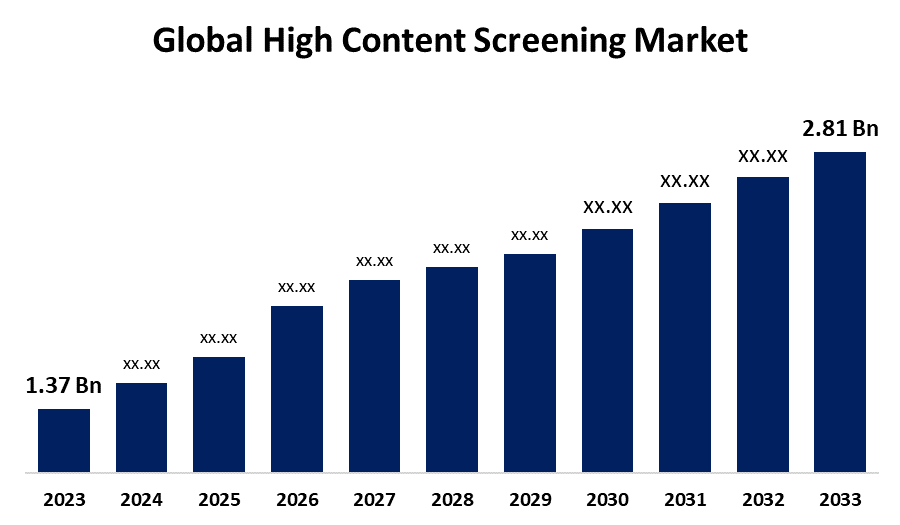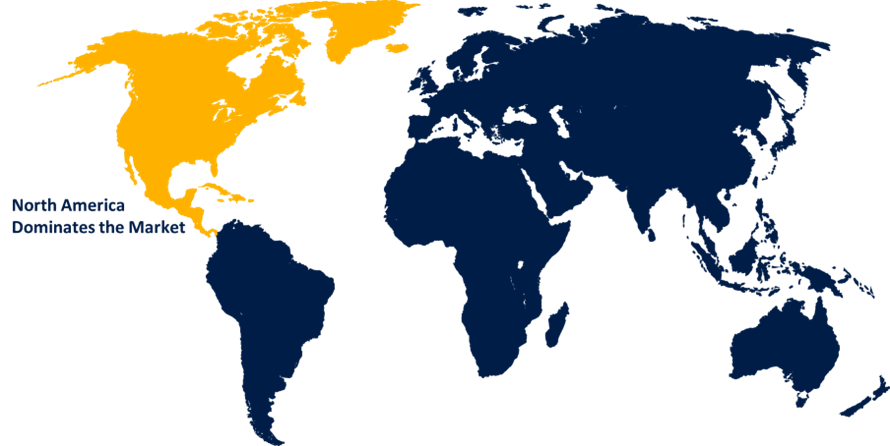Global High Content Screening Market Size, Share, and COVID-19 Impact Analysis, By Product & Service (Instruments, Consumables & Accessories, Software, and Services), By Application (IT & Telecom, BFSI, Government & Defense, Healthcare, Energy, and Others), and By Region (North America, Europe, Asia-Pacific, Latin America, Middle East, and Africa), Analysis and Forecast 2023 - 2033
Industry: HealthcareGlobal High Content Screening Market Insights Forecasts to 2033
- The Global High Content Screening Market Size was estimated at USD 1.37 Billion in 2023
- The Global High Content Screening Market Size is Expected to Grow at a CAGR of around 7.45% from 2023 to 2033
- The Worldwide High Content Screening Market Size is Expected to Reach USD 2.81 Billion by 2033
- Asia Pacific is Expected to Grow the fastest during the forecast period.

Get more details on this report -
The Global High Content Screening Market Size is Expected to cross USD 2.81 Billion by 2033, Growing at a CAGR of 7.45% from 2023 to 2033. A neurodegenerative illnesses like cancer, Alzheimer's, and Parkinson's disease become more common, there is a greater need for sophisticated medical treatment, which is driving the growth of the high content screening market.
Market Overview
The sector centered on sophisticated cell-based imaging and analysis methods utilised for high-throughput screening in toxicology, drug development, and biomedical research is known as the high content screening (HCS) market. The high content screening market effectively assesses cellular responses by combining automated microscopy, image analysis, and data processing. The use of 3D cell cultures, AI-powered imaging technologies, and the growing need for precision medicine are driving the industry. Companies in the biotechnology and pharmaceutical industries are major participants, using HCS to create drugs quickly and accurately.
The use of HCS in customized medicine and the growing number of contract research firms offering HCS outsourcing services provide the industry with substantial development opportunities in the high content screening market. For instance, in January 2025, Danaher launched the fifth-generation high-content imager, which stands out for its speedy capture of crystal-clear photos of intricate cell models, its ability to gather extensive data using user-friendly software, and its capacity to provide profound insights through AI-driven analysis.
The growing use of HCS in cell-based assays, cancer research, and personalized medicine drives the high content screening market. Government funding and venture capital investments across developed markets, the need to reduce the cost of pharmaceutical research and development, and improvements in imaging tools and informatics solutions are the main factors driving the high content screening market.
Report Coverage
This research report categorizes the high content screening market based on various segments and regions forecasts revenue growth and analyzes trends in each submarket. The report analyses the key growth drivers, opportunities, and challenges influencing the high content screening market. Recent market developments and competitive strategies such as expansion, type launch, development, partnership, merger, and acquisition have been included to draw the competitive landscape in the market. The report strategically identifies and profiles the key market players and analyses their core competencies in each sub-segment of the high content screening market.
Global High Content Screening Market Report Coverage
| Report Coverage | Details |
|---|---|
| Base Year: | 2023 |
| Market Size in 2023: | USD 1.37 Billion |
| Forecast Period: | 2023-2033 |
| Forecast Period CAGR 2023-2033 : | 7.45% |
| 2033 Value Projection: | USD2.81 Billion |
| Historical Data for: | 2019-2022 |
| No. of Pages: | 250 |
| Tables, Charts & Figures: | 150 |
| Segments covered: | By Application, By Region, and COVID-19 Impact Analysis. |
| Companies covered:: | BD, Merck KGaA, Sartorius AG, Evident, Tecan Trading AG, Revvity Inc., Sysmex Corporation, Corning Incorporated, Carl Zeiss AG, Nikon Corporation, Agilent Technologies Inc., Danaher Corporation, Thermo Fisher Scientific Inc., Bio-Rad Laboratories Inc.,and Others. |
| Pitfalls & Challenges: | COVID-19 Empact,Challenges, Future, Growth, & Analysis |
Get more details on this report -
Driving Factors
Rising investments, increased R&D efforts globally, and recent technical advancements by researchers and industry participants are all driving the high content screening market's expansion. The growing need for customized medicine, drug research and discovery, and drug toxicity studies, among other things, is driving the market for high content screening's robust growth trajectory. The market is expanding as a result of the comprehensive research and development efforts in the areas of medication discovery and innovation.
The market for high-content screening is anticipated to expand as a result of the rising need for effective and efficient drug discovery on a worldwide scale. The growing demand for effective and efficient drug discovery and development procedures is anticipated to drive substantial growth in the high content screening market.
Restraining Factors
One of the main factors that is anticipated to limit market expansion is the high cost of HCS tools. The result might restrict the market's growth by limiting the use of HCS tools, particularly among small and medium-sized research groups.
Market Segmentation
The high content screening market share is classified into product & service and application.
- The instruments segment held the largest share in 2023 and is expected to grow at a significant CAGR during the forecast period.
Based on the product & service, the high content screening market is divided into instruments, consumables & accessories, software, and services. Among these, the instruments segment held the largest share in 2023 and is expected to grow at a significant CAGR during the forecast period. Cell imaging systems, cell detection & analysis systems, and high-content imaging platforms make up the instrument segment. The usage of 3D cell cultures and phenotypic screening, which call for specific chemicals for precise imaging and analysis, is driving the market expansion.
- The healthcare segment is anticipated to witness the fastest CAGR growth during the forecast period.
Based on the application, the high content screening market is divided into IT & telecom, BFSI, government & defense, healthcare, energy, and others. Among these, the healthcare segment is anticipated to witness the fastest CAGR growth during the forecast period. The growing need for biomarker identification, medication discovery, and AI-powered imaging technologies is driving the expansion of the healthcare sector. The growth of high-content screening is further fueled by its increasing use in biotechnology and pharmaceutical research.
Regional Segment Analysis of the High Content Screening Market
- North America (U.S., Canada, Mexico)
- Europe (Germany, France, U.K., Italy, Spain, Rest of Europe)
- Asia-Pacific (China, Japan, India, Rest of APAC)
- South America (Brazil and the Rest of South America)
- The Middle East and Africa (UAE, South Africa, Rest of MEA)
North America is anticipated to hold the largest share of the high content screening market over the predicted timeframe.

Get more details on this report -
North America is anticipated to hold the largest share of the high content screening market over the predicted timeframe. North America is the market leader for HCS worldwide and is anticipated to have a sizable market share for the foreseeable future. The need for precise and effective HCS solutions is further fueled by the US's increasing emphasis on drug development, regenerative medicine, and customized healthcare. Because of its robust research lab infrastructure, emphasis on innovation, and extensive network of biopharma firms, CROs, and CDMOs, the US leads the North American market.
Asia Pacific is expected to grow at the fastest CAGR growth of the high content screening market during the forecast period. The number of pharmaceutical businesses operating in China has significantly increased, and the nation boasts a vast pool of highly qualified scientists and researchers who are always looking for fresh and creative approaches to medication development and discovery. The high content screening market in China, which refers to the examination of cells and biomolecules using automated microscopy and image analysis techniques, is anticipated to be driven by the growing emphasis on innovation and drug development.
Europe is predicted to hold a significant share of the high content screening market throughout the estimated period. Europe is the statistical agency of the European Union, responsible for releasing Europe-wide data and indicators that enable comparisons across nations and regions. Hospitals were the largest payers of healthcare services in the EU in 2020, accounting for over two-fifths (37.4%) of all healthcare spending. One of the main factors contributing to the increasing European HCS market is the expansion of healthcare infrastructure.
Competitive Analysis:
The report offers the appropriate analysis of the key organizations/companies involved within the high content screening market along with a comparative evaluation primarily based on their type of offering, business overviews, geographic presence, enterprise strategies, segment market share, and SWOT analysis. The report also provides an elaborative analysis focusing on the current news and developments of the companies, which includes type development, innovations, joint ventures, partnerships, mergers & acquisitions, strategic alliances, and others. This allows for the evaluation of the overall competition within the market.
List of Key Companies
- BD
- Merck KGaA
- Sartorius AG
- Evident
- Tecan Trading AG
- Revvity Inc.
- Sysmex Corporation
- Corning Incorporated
- Carl Zeiss AG
- Nikon Corporation
- Agilent Technologies Inc.
- Danaher Corporation
- Thermo Fisher Scientific Inc.
- Bio-Rad Laboratories Inc.
- Others
Key Target Audience
- Market Players
- Investors
- End-users
- Government Authorities
- Consulting And Research Firm
- Venture capitalists
- Value-Added Resellers (VARs)
Recent Development
- In January 2025, BD signed a collaboration contract to allow and ease the integration of robotic arms with BD flow cytometry equipment in order to expedite the development of new drugs.
- In January 2024, the Cell Voyager High-Content Analysis System CQ3000, which includes image analysis software and cell observation equipment, was launched by Yokogawa Electric Corporation.
Market Segment
This study forecasts revenue at global, regional, and country levels from 2023 to 2033. Spherical Insights has segmented the high content screening market based on the below-mentioned segments:
Global High Content Screening Market, By Product & Service
- Instruments
- Consumables & Accessories
- Software
- Services
Global High Content Screening Market, By Application
- IT & Telecom
- BFSI
- Government & Defense
- Healthcare
- Energy
- Others
Global High Content Screening Market, By Regional Analysis
- North America
- US
- Canada
- Mexico
- Europe
- Germany
- UK
- France
- Italy
- Spain
- Russia
- Rest of Europe
- Asia Pacific
- China
- Japan
- India
- South Korea
- Australia
- Rest of Asia Pacific
- South America
- Brazil
- Argentina
- Rest of South America
- Middle East & Africa
- UAE
- Saudi Arabia
- Qatar
- South Africa
- Rest of the Middle East & Africa
Frequently Asked Questions (FAQ)
-
1. What is the CAGR of the high content screening market over the forecast period?The high content screening market is projected to expand at a CAGR of 7.45% during the forecast period.
-
2. What is the market size of the high content screening market?The Global High Content Screening Market Size is Expected to Grow from USD 1.37 Billion in 2023 to USD 2.81 Billion by 2033, at a CAGR of 7.45% during the forecast period 2023-2033.
-
3. Which region holds the largest share of the high content screening market?North America is anticipated to hold the largest share of the high content screening market over the predicted timeframe.
Need help to buy this report?